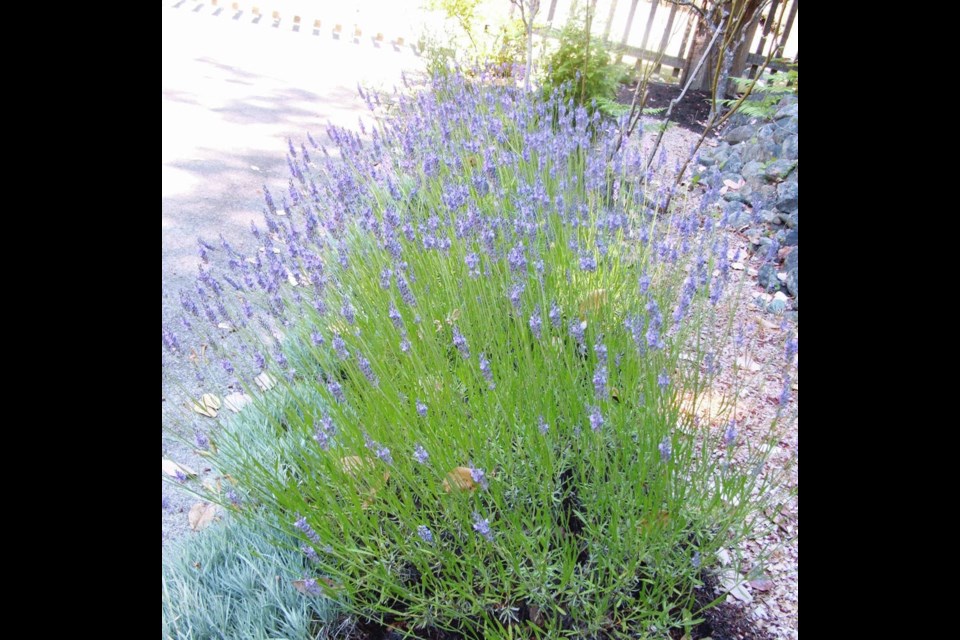Dear Helen: I’ve lost the lavender shortbread recipe you had in a past column. Could you please repeat it, for me and for others I’m sure would like to try it?
R.P.
This question comes in the mail every year, usually in early summer as lavender plantings begin to flower. Here is the recipe.
Lavender Shortbread
1 1/2 cups butter at room temperature
2/3 cup sugar
2 Tbsp chopped lavender florets
1 Tbsp chopped fresh mint
2 1/3 cups flour
1/2 cup corn starch
1/4 Tsp salt
Cream first four ingredients together, until light and fluffy. Add flour, corn starch and salt. Beat until combined. Divide the dough in half, flatten into squares, and wrap in plastic. Chill until firm. On a floured board, roll or pat out each square to a thickness of three-eighths inch. Cut the dough into one and one-half inch squares or rounds, and transfer to baking sheets that are covered with parchment paper. Space them one inch apart, and prick each cookie several times with the tines of a fork.
Bake 20 to 25 minutes at 325 F, until pale golden. Do not allow the shortbread to brown. Cool slightly, transfer to a rack to finish cooling, and store in sealed containers.
Dear Helen: One of my compost enclosures is almost empty now, its fully decomposed contents spread over the vegetable plots. Before I begin filling the enclosure again, I’d like to know whether you place any special materials as the base layer of an enclosure about to be re-filled. And do you build a compost heap using specific layers of different materials?
C.A.
I place cardboard topped with thick layers of newspaper at the base of a cleaned-out compost enclosure. This helps to prevent root invasion from nearby trees and shrubs into the area. Then, I put a thick layer of some coarse but absorbent material such as saved leaves or chopped straw. These base layers help to retain moisture and nutrients draining through the composting layers above.
In a perfectly cared-for garden where compost heaps are meticulously watched over, a pile of composting materials would never be allowed to become wet enough to leach nutrients from the heap. Alas, In the very imperfect world that is my garden, heaps have occasionally been left uncovered in heavy rains. Thus the precautions.
I don’t separate materials destined for the compost in order to “layer” them. Usually, there is a naturally occurring balance between soft, green matter and older, drier materials for the pile to break down effectively. You’ll know if there is too much soft, green (nitrogen-rich) matter: The heap will give off an odour I think of as “eau de horse barn.” A heap lacking the activating green materials will be slow to break down.
Dear Helen: This is the first time I’ve over-wintered carrots in my garden. I dug up the last ones two weeks ago. They had new top growth and the roots had produced an abundance of light “hair.” Is this normal, or unique to the variety I grew? It’s annoying to have all that hair to shave off.
H.Y.
Ideally, over-wintered carrots are dug and refrigerated before much new top growth appears. I don’t always manage that and I dug my last roots at about the same time you did. They are still usually fine eating, and the hairs come off with a stiff brushing.
Carrots are biennials; that is, after growing for a year they winter over and then develop more roots and top growth that will include a flowering stem. The plants’ second year is their year for flowering and producing seed for the next generation.
Gardening in pots. Next in the Peninsula Garden Club speaker series is Jennifer Lasko presenting Creating a Garden in Pots on Monday at 7 p.m. on Zoom. New members are welcome. Membership is required to access a link to the presentation. Check out the club’s list of speakers and how to become a member at peninsulagardenclub.ca.
Plant sale. The Peninsula Garden Club is holding a Spring Plant Sale on Saturday, April 17, from 9 a.m. to 12 p.m. at three locations: 9313 Carnoustie Cresc. (off Bradley Dyne) in Ardmore; 10661 MacDonald Park Rd. in North Saanich; 9600 Third St. at Ocean Ave. in Sidney. Cash in small bills and change, and cheques, are welcome. Social distancing and masks are required.



